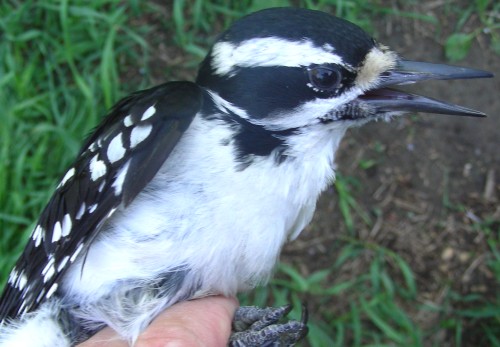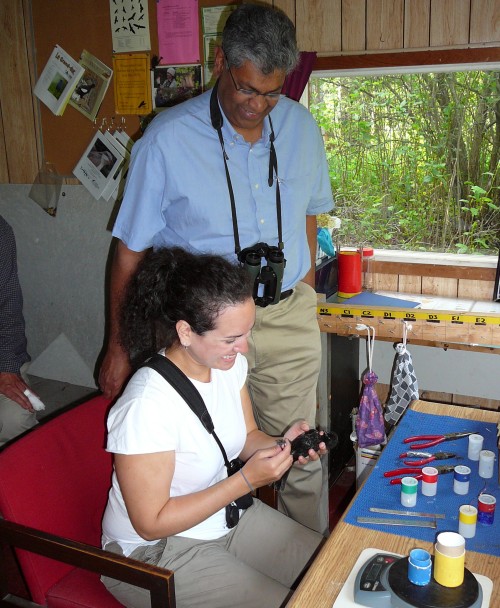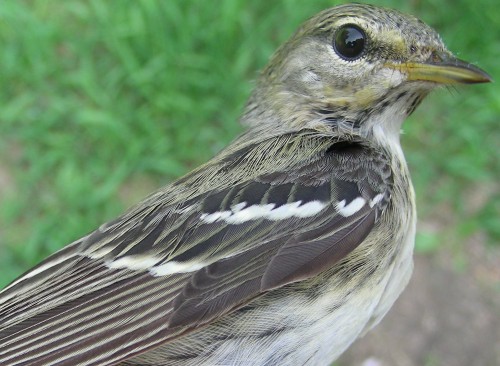|
McGILL BIRD OBSERVATORY |
|||||||||||||||||||||||||||||||||||||||||||||||||||||||||||||||
Welcome
to the McGill Bird Observatory weekly report.
Click here for a complete listing of our archives.
Banders-in-charge:
Marie-Anne Hudson, Barbara Frei Notes: It’s hard to believe that the 2007 Spring Season is almost over – it feels as if it just began! Migration has definitely slowed over this past week, likely due to a consistent westerly wind (varying between the occasional southwest wind, but usually a northwest wind) and the fact that we’re almost in June. Despite the slowing though, we experienced a very interesting week unlike any other to date: we were inundated by Blackpoll Warblers! Their high-pitched “tseeeep tseeeep tseeeep” calls emanated from pretty much everywhere, though they especially liked the hawthorns and buckthorns surrounding the A and E nets. If today’s birds were any indication (fat scores of 6 and 7 – you’ve never seen little butterballs like these guys!), they’ll likely leave on the first good tail wind, so enjoy them while you can! Despite the apparent slowing of migration, our lowest DET was still 48 species, with a mean of 52 species for the week. This is a little lower than last year’s week 9, and is likely due to those westerly winds mentioned earlier (as opposed to southerly for a good part of the week last year). New arrivals include both Alder and Willow Flycatchers and Swainson’s Thrush. Six new species were banded: Swainson’s Thrush, Veery, American Redstart, Northern Rough-winged Swallow, Cedar Waxwing, and Red-eyed Vireo. There are still a few species missing from our totals that we had at this time last year: Indigo Buntings are proving to be quite elusive (observed but not banded), as are Gray-cheeked Thrushes and Philadelphia Vireos – they haven’t shown up at all yet! This didn’t seem to faze the Dean of Macdonald Campus, Chandra Madramootoo, who came out for a visit on Thursday. David Bird and Rodger Titman kindly served as enthusiastic hosts, guiding the Dean around the site and offering up historical tidbits. We certainly hope he enjoyed his visit, and extend him an open invitation to return!
Our top ten species observed list is quite different from last week’s, with several new additions: Baltimore Oriole, Cedar Waxwing, and of course, Blackpoll Warblers. However, the top spot again goes to the Red-winged Blackbird for the fourth week in a row. The rest of the list is rounded out by the ‘usual suspects’. Notable differences from last year are the relative scarcity of Ring-billed Gull and Mallard (ranked 1st and 4th for this week in 2006), and again the higher number of Tree Swallows compared to 2006, that we have now been noting for several weeks. The top ten banded list was significantly upset this week with Red-winged Blackbirds falling to a distant second position behind the Blackpolls. The warblers occupied half of the top ten spots, with several little species-specific ‘pushes’ throughout the week: Northern Waterthrush on Friday and Wilson’s Warbler on Tuesday. A flock of Cedar Waxwings hanging around MBO also managed to find its way into our nets on a sporadic basis, pushing them to third position. A strong movement of Gray Catbirds and Baltimore Orioles mid-week brought in several new individuals. On the whole, six of this week's top 10 were also on the list last year at this time, again showing a fair bit of consistency from year to year, though we know there will always be surprises each spring like this week's Blackpoll invasion - and that's what keeps things interesting! Going into our last week of spring banding, we wonder what the forecasted southwest winds and rain might bring in (hopefully the rain will come in overnight and not interfere with our operations!). We very much look forward to seeing you out at MBO for our last week, and thank you for your continued enthusiasm!
|



